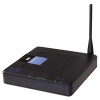Cisco WRH54G User Guide - Page 36
The Security Tab - VPN Passthrough, The Security Tab - ARP
 |
View all Cisco WRH54G manuals
Add to My Manuals
Save this manual to your list of manuals |
Page 36 highlights
Wireless-G Home Router When you finish making changes to this screen, click the Save Settings button to save the changes, or click the Cancel Changes button to undo your changes. Help information is shown on the right-hand side of the screen. For additional help, click More. The Security Tab - VPN Passthrough Use the settings on this tab to allow VPN tunnels using IPSec, PPTP, or L2TP protocols to pass through the Router's firewall. IPSec Passthrough. Internet Protocol Security (IPSec) is a suite of protocols used to implement secure exchange of packets at the IP layer. To allow IPSec tunnels to pass through the Router, click Enable. IPSec Pass-Through is enabled by default. PPTP Passthrough. Point-to-Point Tunneling Protocol (PPTP) allows the Point-to-Point Protocol (PPP) to be tunneled through an IP network. To allow PPTP tunnels to pass through the Router, click Enable. PPTP PassThrough is enabled by default. L2TP Passthrough. Layer 2 Tunneling Protocol is the method used to enable Point-to-Point sessions via the Internet on the Layer 2 level. To allow L2TP tunnels to pass through the Router, click Enable. L2TP Pass-Through is enabled by default. When you finish making changes to this screen, click the Save Settings button to save the changes, or click the Cancel Changes button to undo your changes. Help information is shown on the right-hand side of the screen. For additional help, click More. The Security Tab - ARP Prevent ARP attack. Enable/Disable the Prevent ARP attack. ARP Broadcast Rate. Set frequency for Router to broadcast the MAC address. If "Random" is selected, the frequency is 1 to 9 times per second. To manually specify the number of broadcast per second, choose "Fixed schedule". "0" value means that the broadcast will not be sent out. Edit IP-MAC mapping list. Click on "Edit IP-MAC mapping list" to enter into IP-MAC binding page. To add a new IP-MAC address mapping list, enter the IP address and MAC Address accordingly on the top section. Then click the "Add" button to add it into the list below. Note that if the entry of IP-MAC address mapping list already exists, the Router will ignore the new add-in. If the IP address is already entered, the Router will replace it with the new MAC address. Chapter 5: Configuring the Wireless-G Home Router The Security Tab - VPN Passthrough Figure 5-29: Security Tab - VPN Passthrough Figure 5-30: Security Tab - ARP 29















